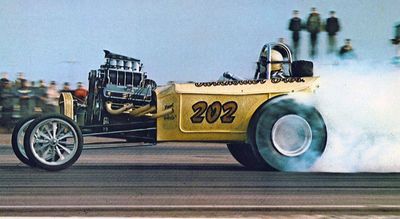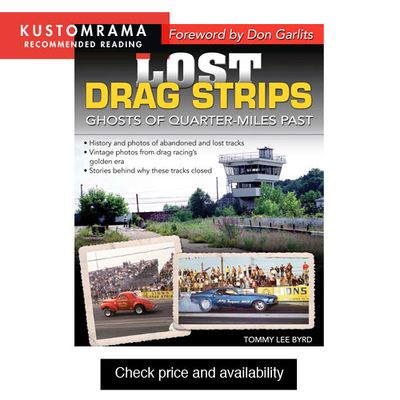The Burkholder Brothers





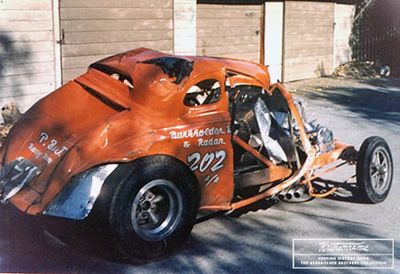








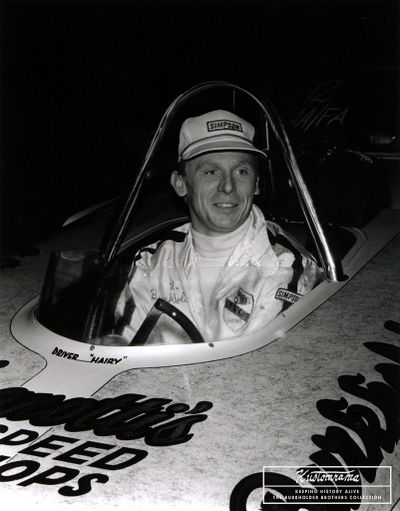
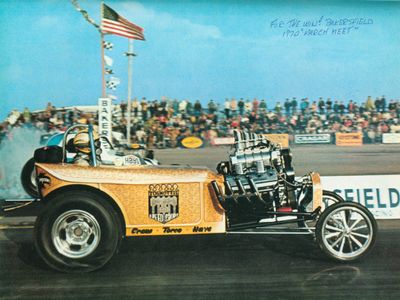
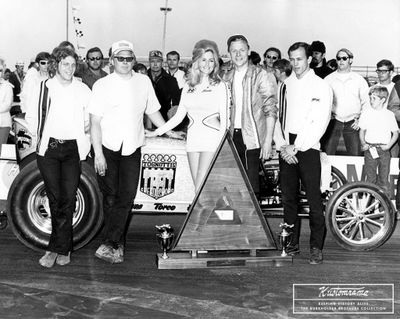
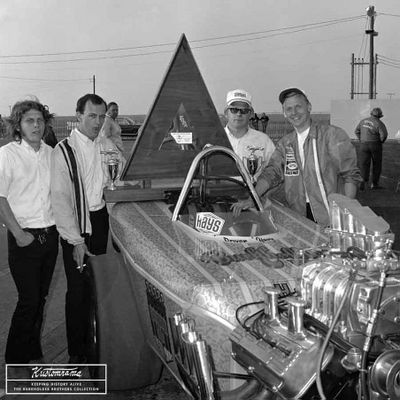

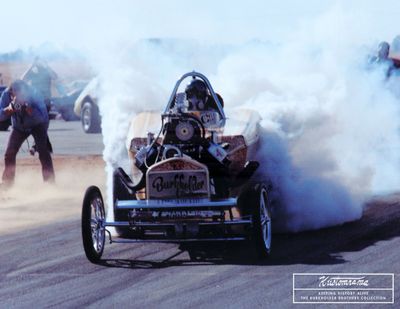



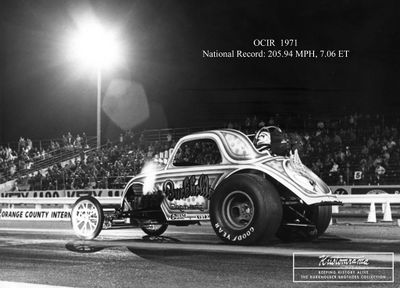







The story of the Burkholder Brothers, Pete and Harry, begins in the small town of Yreka in California, about four hours north of Sacramento. Pete was born in 1939, and his brother Harry a year later. Shortly after the brothers were born, the family moved down to the state capital, Sacramento, and it is here that our real story takes off.[1]
Contents
- 1 Bitten by the Dry Lakes Racing Bug
- 2 Build Hot Rods and Compete
- 3 First Cars
- 4 The Burkholder Brothers' 1934 Ford 5-Window Coupe - The Flying Fox
- 5 Drag Racing Career
- 6 The Beginning of the End of Their First Race Car
- 7 Pete and Harry Teams Up With Don Argee and Lawrence Brocchini
- 8 Drag Racing is Addictive
- 9 The Outcast
- 10 The Burkholder Brothers' T-23
- 11 Hairy Harry
- 12 The Fiat Topolino
- 13 The Brotherhood Funny Car Team
- 14 References
Bitten by the Dry Lakes Racing Bug
The environment and close friends are said to be what affects one's own life, and nothing could fit better with these brothers. In the house where the family lived, their cousin Bob Zetz and his friend Joe Radan also lived. The two were actively competing with cars on the dry lake beds, that is, dry lake racing, and this quickly caught on with Pete and Harry. It was also through Bob that the brothers met local hot rodders such as Don Argee, Lawrence Brocchini, Ed Cortopassi, Dick Bertolucci, and Harold Bagdasarian. Most of them were active in the local car club Thunderbolts.[1]
Build Hot Rods and Compete
The young brothers took in everything they could and were soon enthusiastic motor enthusiasts. All they wanted to do now was build hot rods and compete. When they were teenagers, they both worked at a local gas station. Harry shared this story with Kustomrama-contributor Henrik Forss: "Both Pete and I went to high school, but we got our education in car mechanics from working after school at Ed Smith's Shell gas station at 23rd and F Street. (the building is still there, by the way) We wanted to work with cars. That was all that existed."[1]
First Cars
Harry continued to tell how it was in the beginning. "Pete liked to paint cars, and soon enough, he got a job at Wion Brothers Body Shop. His first car was a 40 Ford Coupe with an Oldsmobile engine. A really nice car that he exhibited at the Sacramento Autorama. My first car was a 1941 Ford I bought when I was 14 years old. I tidied it up and reupholstered the interior before I even had a driver's license. We were self-taught guys, like so many others. I helped friends with engine swaps and installed many Oldsmobile engines in old Fords. In the evenings, we hung out at local drive-ins and cruised on K Street here in Sacramento."[1]
The Burkholder Brothers' 1934 Ford 5-Window Coupe - The Flying Fox
Soon enough, gas-happy Harry lost his driver's license. He had already received too many speeding tickets. That's when the idea to build a racing car was born. The brothers were not even 20 years old. They rented a garage in the city center from car show organizer Harold Bagdasarian (Sacramento Autorama), and here they began building what would become the first in a long line of coupes and roadsters with short wheelbases and large engines. The first build was based on a very fine 1934 Ford that Pete had, a coupe that was quickly sawed apart. The body was mounted and lowered over an A Ford frame they had gotten from cousin Bob Zetz. Bob and his friend Joe were always on site and taught the young men how to weld and provided assistance when needed. The engine was taken out of a 1954 Oldsmobile that Pete had crashed on a rainy evening on the way home from work. The 354 cui Oldsmobile engine was bored 0.30" and received a 3/8 stroked crank and reinforced crankpins. They installed a Vertex magnet, a 6:71 GMC compressor, and a Hilborn injector. The car made its debut in February 1959, and the first test drive was done on a public road just north of the city.[1]
Drag Racing Career
At this time, Pete was already an experienced sheet metal and paint guy who always ensured their racing car looked good while Harry worked on the drivetrain and chassis. A setup that has continued through all the years of competition. In 1961, the brothers also lent the coupe to a friend, Rich Richmond, who wanted to set a record at Bonneville. Harry explained, "Yeah, Rich had set the record for highboy roadsters at Bonneville and wanted to take the record in the coupe class too. So I mounted his Hemi engine in our coupe and lent him the car. I had just gotten a full-time job and couldn't go with him. Unfortunately, his engine had a little too much compression, so instead of setting a record, he blew the engine." Harry was the one who drove the car in the drag races, but big brother Pete also wanted to try.[1]
The Beginning of the End of Their First Race Car
Pete got his chance at the end of 1961 at Vaca Valley, where they had drag races every weekend. Harry remembers that day very well. "I drove the car first that day and qualified at 144 mph. After that, I told my brother it was his turn to drive. He did some test runs on the side of the track that went well, and finally, it was time to race. It seemed promising; he drove 142 mph, but the brake chute, which we bought used from the army surplus store, never deployed. So Pete sailed off across the fields and rolled three times before stopping upside down. He came out pretty good, but I don't think the car would have held together if it had rolled one more time." This was the beginning and end of their first race car. They managed to race with it for a few years before the accident, mostly on tracks like Kingdon, Vaca Valley, and Fremont. The best time they achieved in the sleek build was 9.90 seconds and 150 mph.[1]
Pete and Harry Teams Up With Don Argee and Lawrence Brocchini
The next car Pete and Harry built ended up racing in several different forms between 1962-1967. Harry designed and built the car while Pete took care of the sheet metal and paint work. The NHRA regulations required the use of sheet metal bodies, so the brothers decided to use a 1948 Fiat body. They used the engine from the crashed '34 Ford. Soon, they were down to 9.30 times and close to 155 mph. Both brothers now had well-paid "normal" jobs, and they were finally able to build what they called the "monster motor." They based it on the 394 cui Olds engine, and Harry installed a 5/8 stroker crankshaft with Mickey Thompson aluminum rods. At the same time, they joined forces with another local team to start driving a fuel altered. They teamed up with Don Argee and Lawrence Brocchini, who were very successful but had recently sold their T-27 roadster. Don had saved his supercharged Chrysler engine, and they installed it in the brothers' chassis, which they attached a T-27 body to. In December 1962, they set a new record for fuel roadsters with 170.77 mph.[1]
Drag Racing is Addictive
In 1964, the partnership with Argee and Brocchini ended. Pete enlists in the army while Harry continues to race their Fiat on a more modest scale. While in the army, Pete started to lose interest in drag racing and instead considered buying a Corvette and driving across the country when he got out. But when he found out that his brother Harry had set a new track record at Fremont with 155.96 mph, he got the racing bug again, and it was all about drag racing once more. Drag racing is addictive.[1]
The Outcast
The third version of their build got a roadster body instead of the Fiat. Now, the NHRA allowed the use of fiberglass bodies. They installed their "monster motor" in the chassis. The car was named "Outcast," and it was constantly developed. At first, they raced in the AA/A class and ran on gasoline, but they occasionally tested a methanol/nitro mixture. The 470 cui Olds engine roared like a lion, and they qualified in every race they entered. Five years later, they sold the chassis and bantam body. It was time to move on.[1]
The Burkholder Brothers' T-23
It is now 1967, and the fuel-altered class is becoming popular among competitors and spectators. At tracks like Lions, Irwindale, and Orange County International Raceway, they often booked a 16-car ladder of fuel altereds. The brothers realized it was time to step up and start competing with the guys from Southern California. Harry built a 100” Chromoly chassis with Halibrand torsion suspension. He built the car in his two-car garage, but it had to be inspected and verified to get the chassis approved for racing. This was done by Don Garlits in the staging lanes at the 1968 March Meet in Bakersfield. They made the handmade body from two T-23 aluminum bodies that they bought from a local car manufacturer Kellison. Instead of using a roadster body like many others, the brothers now had a unique touring body. Pete painted it yellow, and it was nice, really nice. In fact, they entered the car in the 1968 Sacramento Autorama and won the award for Outstanding Competition Car. Sponsors now included Tognotti's Speed Shop, Simpson, Crane Cams, and Hays clutches.[1]
Hairy Harry
Pete and Harry raced the car for two years. It consistently ran mid-sevens and went as fast as 200 mph. The highlight for Harry was when they raced the final at Irwindale in 1969 against Wild Willie Borsch and his "Winged Express." Willie won the race by an extremely small margin. The brothers spent a lot of time racing in Southern California throughout all of 1969. They did well, but the thought and idea that it would probably go even better if they switched out the Olds engine for a big Hemi were born! So, Harry started building an engine based on a 392 cui Chrysler. He bored it 0.30" and installed a 3/8 stroker crankshaft made by Valley Ring in Sacramento. The engine got a Crane camshaft, Howard rods, and a Hampton supercharger that worked together with a four-port Hilborn injection. The fuel-altered class was extremely popular in the early 1970s, and the brothers began to fight on tracks in Northern California like both Fremont, but especially their home track in Sacramento. At one of those races in Fremont, something broke in the rear axle, and Harry went off the track and plowed around between the track and the stands in a spectacular way. After that, he got the nickname "Hairy," which still sticks with him.[1]
The Fiat Topolino
In the early 1970s, there was a strong improvement in the clutches on racing cars and their importance for better results. This led Pete to think they should have a body that could be lifted to make it easier to access and work on the drivetrain and chassis, especially the clutch. This is why the brothers retired the T Ford body and replaced it with a Fiat Topolino in 1971. The Fiat also became the last Fuel Altered that the brothers built and raced with and, without a doubt, their most well-known build, now a legend in drag racing history. Their best result was at Orange County International Raceway in 1971, where they set a track record with 7.06 seconds and 204.43 mph. Despite their intense pursuit of the first six-second run, it was a good result. In 1973, the brothers sold their Fiat and looked towards the increasingly popular funny car class, where the big money was now.[1]
The Brotherhood Funny Car Team
The Burkholder brothers teamed up with The Spiegel Brothers, John, Dick, and Steve, and created the "The Brotherhood" funny car team. They used the Hemi that Harry had built for the Topolino and also used the Fiat's clutch. The yellow Plymouth Cuda was built by Sacramento's John Shoemaker, who, by the way, was building his first funny car. Harry drove and ran his best time of 6.93 seconds and 221 mph in 1975. When Henrik Forss asked Harry about this, he told him that the Cuda was too heavy, and since their Hemi engine was based on a cast iron block, they were afraid to extract more than 80% of the power from the engine. "John Spiegel said he would build a new car if I built a Donovan 417 cui engine for it. But at that time, my brother Pete had just had his first child and could no longer attend the races, so I thought if we couldn't continue as the same team, it was just as good to retire," and that's what happened to the Burkholder Brothers. In 2023, the funny car body was on Jeff Gaynor's nostalgic funny car.[1]
References
Did you enjoy this article?
Kustomrama is an encyclopedia dedicated to preserve, share and protect traditional hot rod and custom car history from all over the world.
- Help us keep history alive. For as little as 2.99 USD a month you can become a monthly supporter. Click here to learn more.
- Subscribe to our free newsletter and receive regular updates and stories from Kustomrama.
- Do you know someone who would enjoy this article? Click here to forward it.
Can you help us make this article better?
Please get in touch with us at mail@kustomrama.com if you have additional information or photos to share about The Burkholder Brothers.
This article was made possible by:
SunTec Auto Glass - Auto Glass Services on Vintage and Classic Cars
Finding a replacement windshield, back or side glass can be a difficult task when restoring your vintage or custom classic car. It doesn't have to be though now with auto glass specialist companies like www.suntecautoglass.com. They can source OEM or OEM-equivalent glass for older makes/models; which will ensure a proper fit every time. Check them out for more details!
Do you want to see your company here? Click here for more info about how you can advertise your business on Kustomrama.



